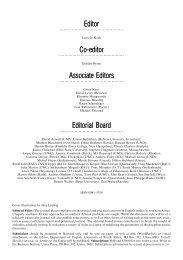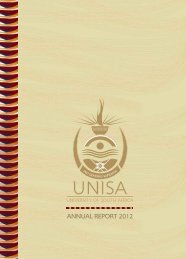Download the Annual report 2011 - Unisa
Download the Annual report 2011 - Unisa
Download the Annual report 2011 - Unisa
Create successful ePaper yourself
Turn your PDF publications into a flip-book with our unique Google optimized e-Paper software.
Total nominal spending by households on education was<br />
approximately R50 billion in <strong>2011</strong>. Based on information<br />
provided by National Treasury about 19% of government<br />
spending was allocated to education, of which<br />
spending on higher education amounted to 15.1%.<br />
Government expenditure on higher education will increase<br />
from R28.3 billion in <strong>2011</strong>/12 to R31.5 billion in<br />
2012/13, thus constituting an 11.3% growth in nominal<br />
terms (approximately 5.1% in real terms).<br />
Higher education environment<br />
during <strong>2011</strong><br />
In his Budget Vote speech at <strong>the</strong> National Assembly in<br />
May <strong>2011</strong>, <strong>the</strong> Minister of Higher Education and Training<br />
signalled that his department’s goals were located<br />
within <strong>the</strong> overall objectives of amongst o<strong>the</strong>r, prioritising<br />
job creation and <strong>the</strong> Human Resources Development<br />
Strategy. Access to decent education and training was<br />
emphasised as being essential for <strong>the</strong> completion of <strong>the</strong><br />
liberation struggle, whose foundation must be economic<br />
liberation. Education is <strong>the</strong>refore <strong>the</strong> apex government<br />
priority and now accounts for 19.4% of <strong>the</strong> total<br />
national budget for April <strong>2011</strong> to March 2012. Of this<br />
allocation universities received R19.4 billion while<br />
R4.3 billion was allocated for Fur<strong>the</strong>r Education and<br />
Training (FET) colleges. R4 billion was allocated to <strong>the</strong><br />
National Student Financial Aid Scheme (NSFAS). With<br />
contributions from universities’ own coffers, NSFAS was<br />
expected to disburse R5.4 billion in loans and bursaries,<br />
double <strong>the</strong> R2.7 billion disbursed in <strong>the</strong> previous year.<br />
The block grant allocation to higher education institutions<br />
has decreased from 86.7% of <strong>the</strong> total government<br />
funding of higher education in 2004/5 to only<br />
75.8% in 2009/10. This percentage has increased<br />
slightly to 76.8% for <strong>2011</strong>/12. As a result, <strong>the</strong> higher<br />
education sector is facing a number of funding challenges:<br />
• A decline in State subsidies may result in increases in<br />
tuition fees, which in turn may lead to an increase in<br />
unpaid student debt<br />
• Inadequate funding of <strong>the</strong> NSFAS; already <strong>the</strong> demand<br />
for financial aid is outstripping <strong>the</strong> amount available.<br />
More than 25% of <strong>the</strong> total undergraduate student<br />
population is on financial aid and <strong>the</strong> demand is still<br />
unfulfilled and rising.<br />
As a result of <strong>the</strong> above, <strong>the</strong> management of <strong>the</strong> increasing<br />
student debt has become an onerous task for most<br />
higher education institutions, as has <strong>the</strong> management of<br />
UNISA ANNUAL REPORT <strong>2011</strong><br />
| 66 |<br />
<strong>the</strong> balance between <strong>the</strong> recovery of outstanding debt<br />
and <strong>the</strong> interest of students to continue with <strong>the</strong>ir studies.<br />
Overview of financial achievements<br />
For <strong>the</strong> financial year under review, <strong>Unisa</strong> recorded an<br />
operating surplus of R639.9 million (2010: R797.6 million).<br />
One of <strong>the</strong> main reasons for <strong>the</strong> decrease in <strong>the</strong><br />
operating surplus is <strong>the</strong> fair value adjustment of investments.<br />
Investments are exposed to <strong>the</strong> volatility of <strong>the</strong><br />
global equity markets and <strong>the</strong> fair value adjustment<br />
changed by 54% from R377 million in 2010 to R174<br />
million during <strong>the</strong> year under review.<br />
Although tuition fee increases were contained at below<br />
10% on average for <strong>the</strong> past few years, revenue from<br />
student fees was 16% higher than in 2010. This increase<br />
is largely due to <strong>the</strong> continuing strong growth in<br />
student numbers during <strong>the</strong> year under review. However,<br />
it should be noted that included in expenses is an<br />
amount of R38 million that was expended to top up<br />
NSFAS funding to <strong>Unisa</strong> students. Expenses also include<br />
an amount of R34 million written off as irrecoverable<br />
and doubtful. Net income from tuition fee income for<br />
<strong>the</strong> year was <strong>the</strong>refore R2.147 billion.<br />
The phased implementation of <strong>Unisa</strong>’s Admissions Policy<br />
should result in a decrease in <strong>the</strong> growth of student<br />
numbers, or even a negative growth, from 2013 onwards.<br />
This would have an adverse effect on income<br />
from tuition fees.<br />
The gross subsidy has increased by 12% to R1.789 billion<br />
in <strong>2011</strong> from R1.605 billion for 2010. However,<br />
R19.7 million (2010: R67.4 million) of <strong>the</strong> teaching and<br />
development grant was deferred to 2012. At <strong>the</strong> time<br />
of <strong>report</strong>ing it was unclear what <strong>the</strong> effect of <strong>the</strong> revised<br />
subsidy formula of <strong>the</strong> Department of Higher Education<br />
and Training (DHET) would be in future years.<br />
Total expenditure for <strong>the</strong> year, including operational and<br />
personnel costs, amounted to R4.012 billion in <strong>2011</strong><br />
(2010: R3.501 billion) – an increase of 15% compared<br />
to <strong>the</strong> previous year. This increase in spending leaves<br />
some cause for concern; <strong>the</strong> year-on-year increase in<br />
spending for 2010 over 2009 was 9% against an average<br />
inflation rate of 4.09%. In <strong>2011</strong> <strong>the</strong> average CPI inflation<br />
in South Africa 5.03% against <strong>the</strong> increased<br />
spending of 13% at <strong>the</strong> university:

















